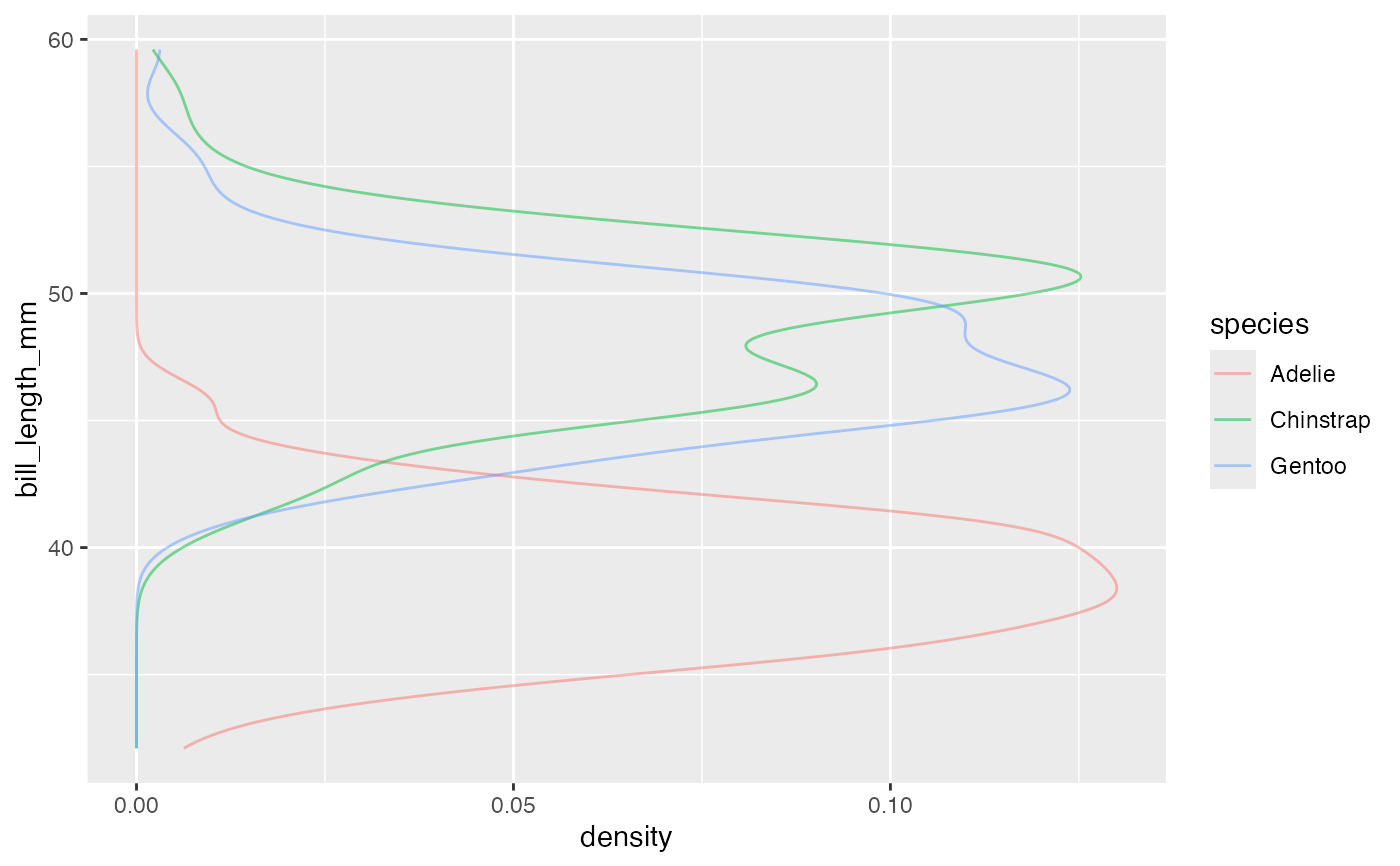Computes and draws a kernel density estimate, which is a smoothed version of the
histogram and is a useful alternative when the data come from an underlying smooth
distribution.
The only difference between gf_dens() and gf_density() is the default geom
used to show the density curve: gf_density() uses an area geom (which can be filled).
gf_dens() using a line geom (which cannot be filled).
Usage
gf_density(
object = NULL,
gformula = NULL,
data = NULL,
...,
alpha = 0.5,
color,
fill,
group,
linetype,
linewidth,
kernel = "gaussian",
n = 512,
trim = FALSE,
xlab,
ylab,
title,
subtitle,
caption,
geom = "area",
stat = "density",
position = "identity",
show.legend = NA,
show.help = NULL,
inherit = TRUE,
environment = parent.frame()
)
gf_dens(
object = NULL,
gformula = NULL,
data = NULL,
...,
alpha = 0.5,
color,
fill = NA,
group,
linetype,
linewidth,
kernel = "gaussian",
n = 512,
trim = FALSE,
xlab,
ylab,
title,
subtitle,
caption,
geom = "line",
stat = "density",
position = "identity",
show.legend = NA,
show.help = NULL,
inherit = TRUE,
environment = parent.frame()
)
gf_dens2(
object = NULL,
gformula = NULL,
data = NULL,
...,
alpha = 0.5,
color,
fill = NA,
group,
linetype,
linewidth,
kernel = "gaussian",
n = 512,
trim = FALSE,
xlab,
ylab,
title,
subtitle,
caption,
geom = "density_line",
stat = "density",
position = "identity",
show.legend = NA,
show.help = NULL,
inherit = TRUE,
environment = parent.frame()
)Arguments
- object
When chaining, this holds an object produced in the earlier portions of the chain. Most users can safely ignore this argument. See details and examples.
- gformula
A formula with shape
~ x. Faceting can be achieved by including|in the formula.- data
The data to be displayed in this layer. There are three options:
If
NULL, the default, the data is inherited from the plot data as specified in the call toggplot().A
data.frame, or other object, will override the plot data. All objects will be fortified to produce a data frame. Seefortify()for which variables will be created.A
functionwill be called with a single argument, the plot data. The return value must be adata.frame, and will be used as the layer data. Afunctioncan be created from aformula(e.g.~ head(.x, 10)).- ...
Additional arguments. Typically these are (a) ggplot2 aesthetics to be set with
attribute = value, (b) ggplot2 aesthetics to be mapped withattribute = ~ expression, or (c) attributes of the layer as a whole, which are set withattribute = value.- alpha
Opacity (0 = invisible, 1 = opaque).
- color
A color or a formula used for mapping color.
- fill
A color for filling, or a formula used for mapping fill.
- group
Used for grouping.
- linetype
A linetype (numeric or "dashed", "dotted", etc.) or a formula used for mapping linetype.
- linewidth
A numerical line width or a formula used for mapping linewidth.
- kernel
Kernel. See list of available kernels in
density().- n
number of equally spaced points at which the density is to be estimated, should be a power of two, see
density()for details- trim
If
FALSE, the default, each density is computed on the full range of the data. IfTRUE, each density is computed over the range of that group: this typically means the estimated x values will not line-up, and hence you won't be able to stack density values. This parameter only matters if you are displaying multiple densities in one plot or if you are manually adjusting the scale limits.- xlab
Label for x-axis. See also
gf_labs().- ylab
Label for y-axis. See also
gf_labs().- title, subtitle, caption
Title, sub-title, and caption for the plot. See also
gf_labs().- geom, stat
Use to override the default connection between
geom_density()andstat_density(). For more information about overriding these connections, see how the stat and geom arguments work.- position
A position adjustment to use on the data for this layer. This can be used in various ways, including to prevent overplotting and improving the display. The
positionargument accepts the following:The result of calling a position function, such as
position_jitter(). This method allows for passing extra arguments to the position.A string naming the position adjustment. To give the position as a string, strip the function name of the
position_prefix. For example, to useposition_jitter(), give the position as"jitter".For more information and other ways to specify the position, see the layer position documentation.
- show.legend
logical. Should this layer be included in the legends?
NA, the default, includes if any aesthetics are mapped.FALSEnever includes, andTRUEalways includes. It can also be a named logical vector to finely select the aesthetics to display. To include legend keys for all levels, even when no data exists, useTRUE. IfNA, all levels are shown in legend, but unobserved levels are omitted.- show.help
If
TRUE, display some minimal help.- inherit
A logical indicating whether default attributes are inherited.
- environment
An environment in which to look for variables not found in
data.
Specifying plot attributes
Positional attributes (a.k.a, aesthetics) are specified using the formula in gformula.
Setting and mapping of additional attributes can be done through the
use of additional arguments.
Attributes can be set can be set using arguments of the form attribute = value or
mapped using arguments of the form attribute = ~ expression.
In formulas of the form A | B, B will be used to form facets using
ggplot2::facet_wrap() or ggplot2::facet_grid().
This provides an alternative to
gf_facet_wrap() and
gf_facet_grid() that is terser and may feel more familiar to users
of lattice.
Evaluation
Evaluation of the ggplot2 code occurs in the environment of gformula.
This will typically do the right thing when formulas are created on the fly, but might not
be the right thing if formulas created in one environment are used to create plots
in another.
Examples
gf_dens()
#> gf_dens() uses
#> * a formula with shape ~x or y ~ ..
#> * geom: line
#> * stat: density
#> * key attributes: alpha = 0.5, color, fill = NA, group, linetype, linewidth,
#> kernel = "gaussian", n = 512, trim =
#> FALSE
#>
#> For more information, try ?gf_dens
data(penguins, package = "palmerpenguins")
gf_density(~bill_length_mm, fill = ~species, data = penguins)
#> Warning: Removed 2 rows containing non-finite outside the scale range
#> (`stat_density()`).
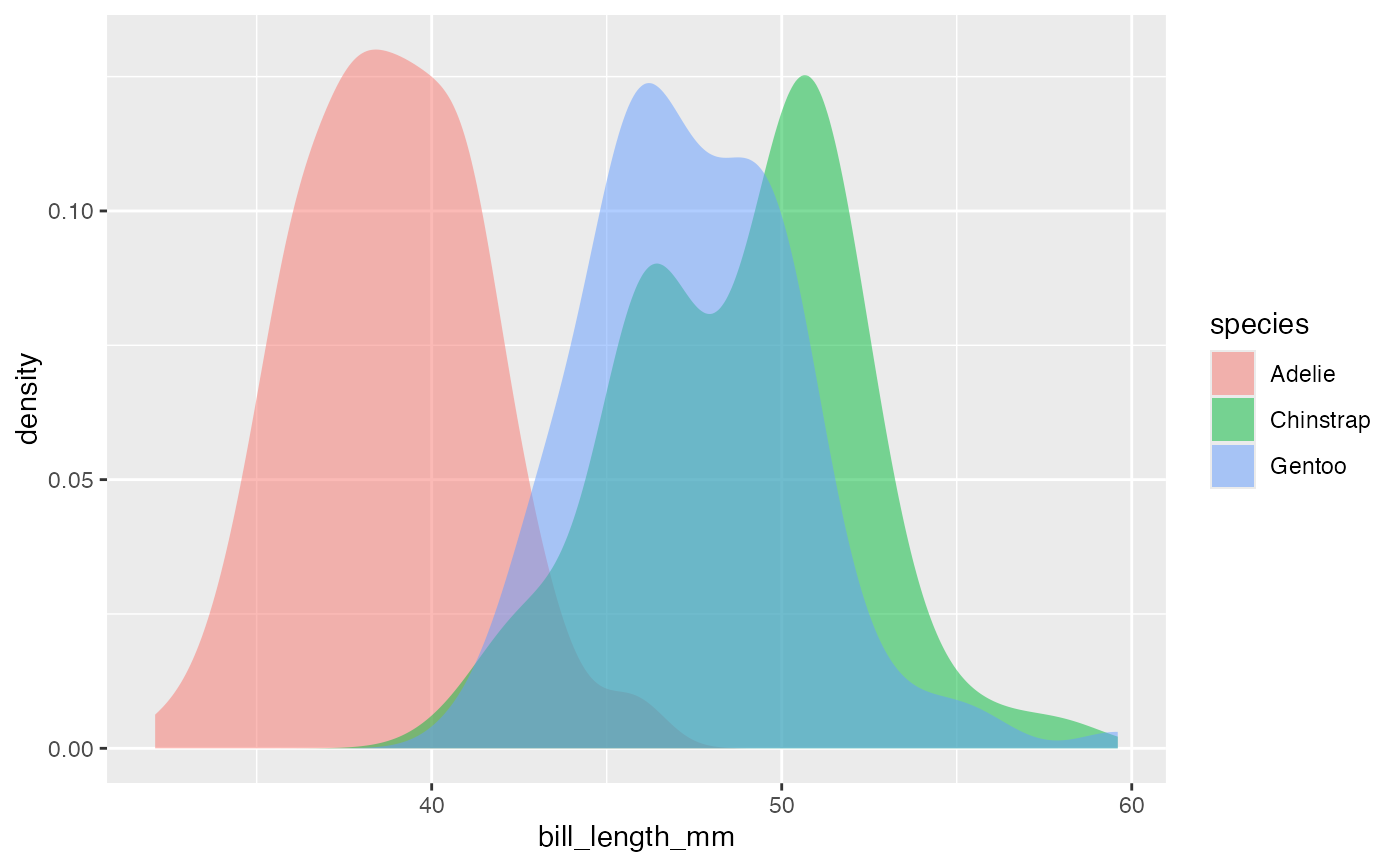 gf_dens(~bill_length_mm, color = ~species, data = penguins)
#> Warning: Removed 2 rows containing non-finite outside the scale range
#> (`stat_density()`).
gf_dens(~bill_length_mm, color = ~species, data = penguins)
#> Warning: Removed 2 rows containing non-finite outside the scale range
#> (`stat_density()`).
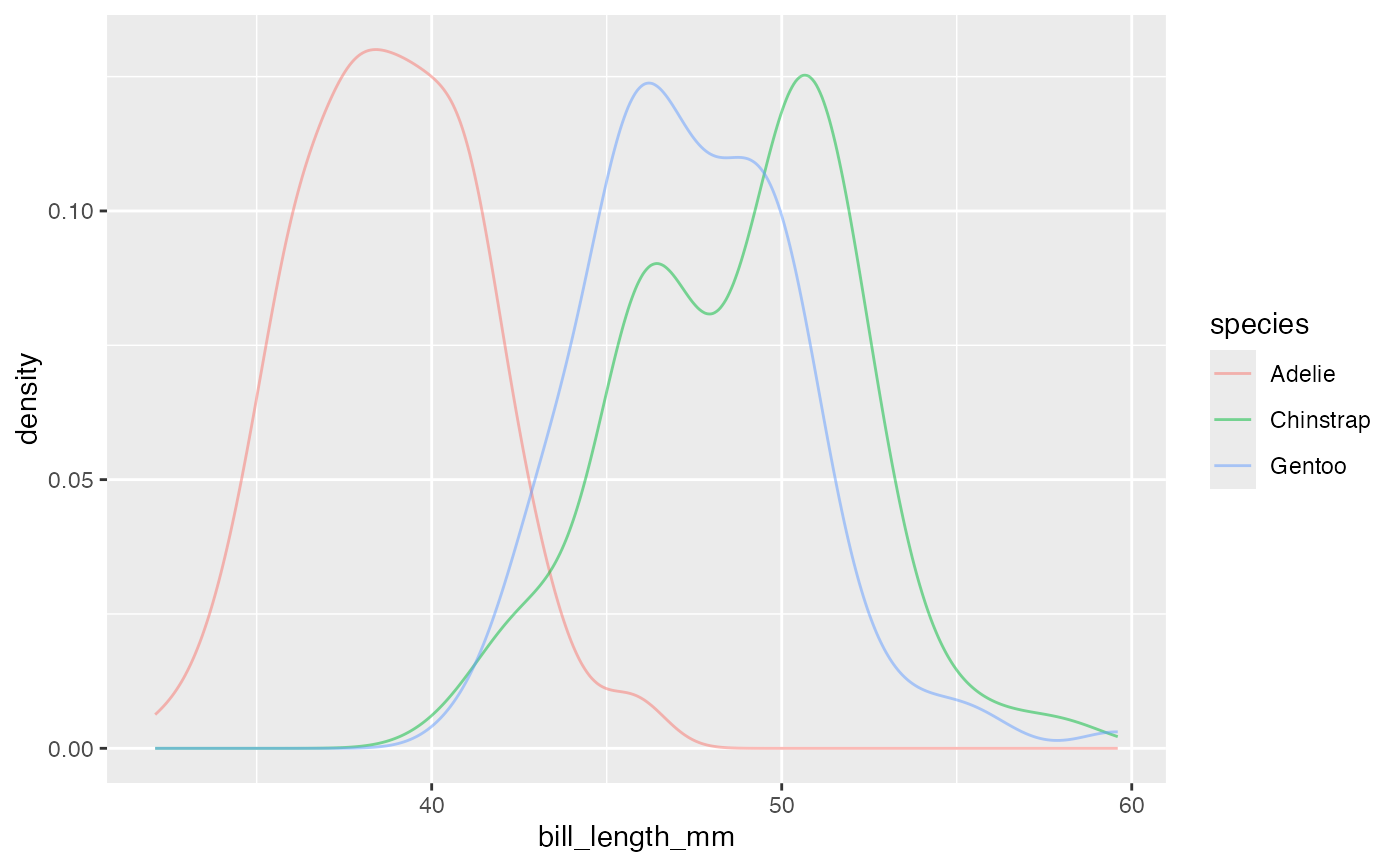 gf_dens2(~bill_length_mm, color = ~species, fill = ~species, data = penguins)
#> Warning: Removed 2 rows containing non-finite outside the scale range
#> (`stat_density()`).
gf_dens2(~bill_length_mm, color = ~species, fill = ~species, data = penguins)
#> Warning: Removed 2 rows containing non-finite outside the scale range
#> (`stat_density()`).
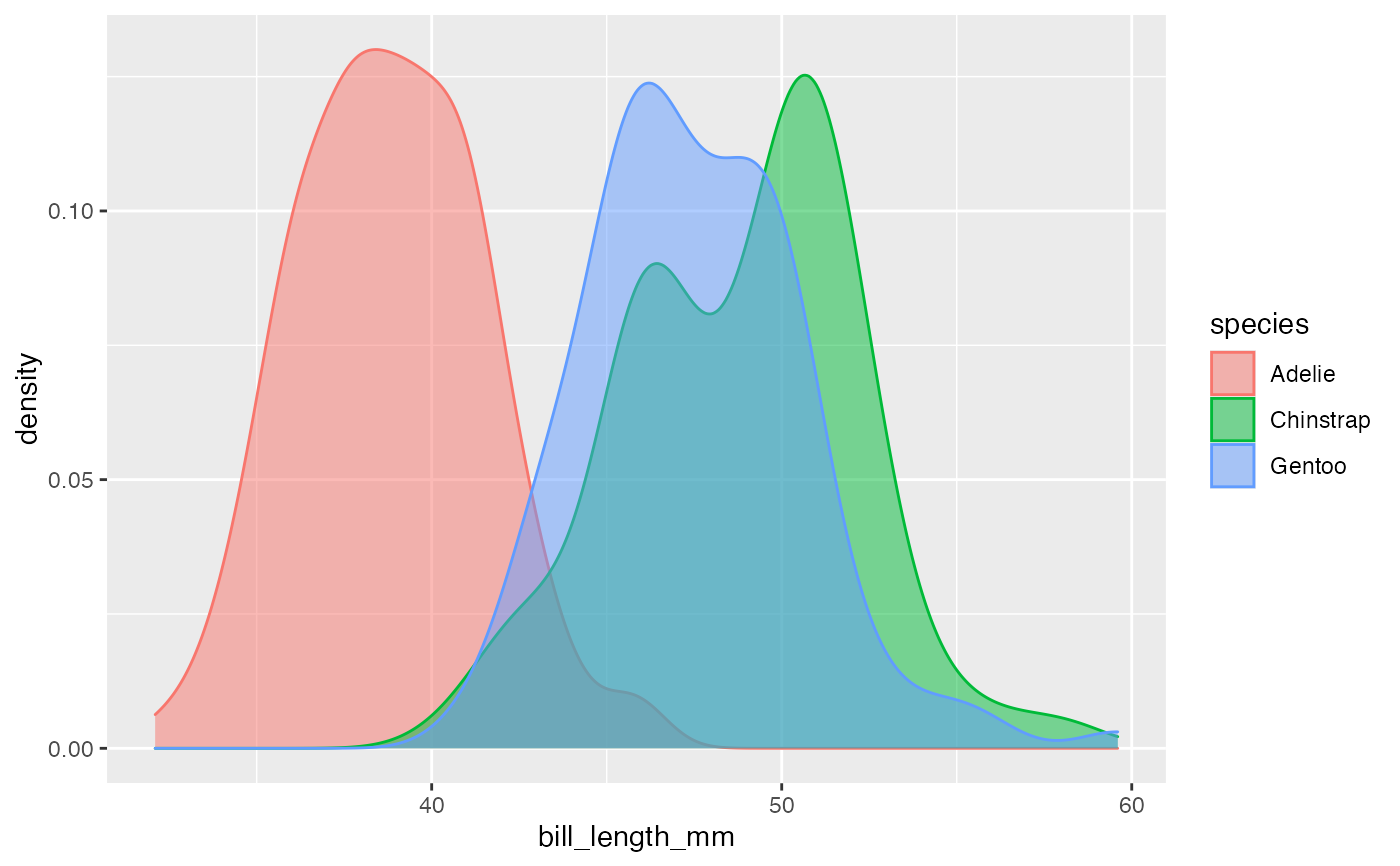 gf_freqpoly(~bill_length_mm, color = ~species, data = penguins, bins = 15)
#> Warning: Removed 2 rows containing non-finite outside the scale range (`stat_bin()`).
gf_freqpoly(~bill_length_mm, color = ~species, data = penguins, bins = 15)
#> Warning: Removed 2 rows containing non-finite outside the scale range (`stat_bin()`).
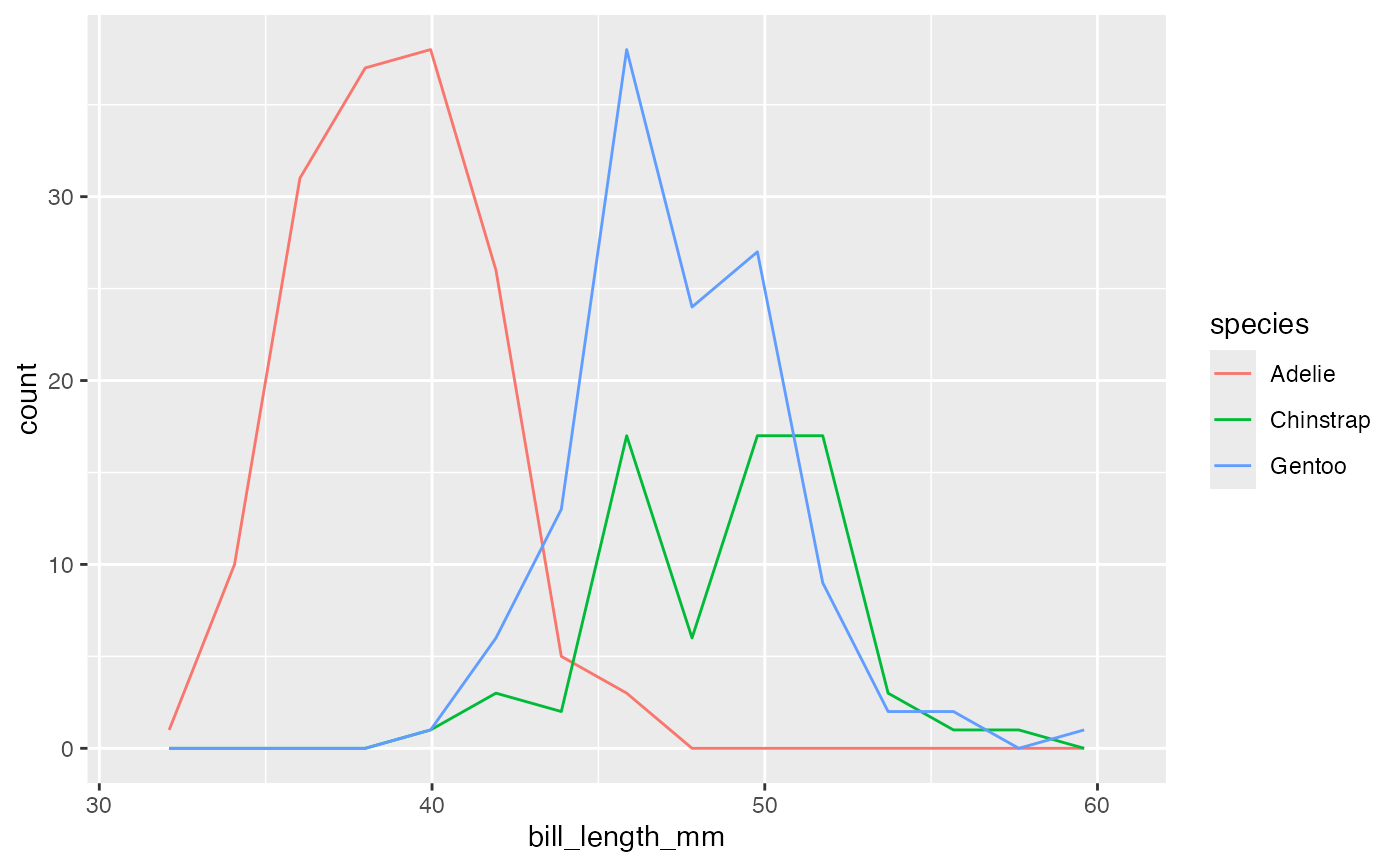 # Chaining in the data
data(penguins, package = "palmerpenguins")
penguins |> gf_dens(~bill_length_mm, color = ~species)
#> Warning: Removed 2 rows containing non-finite outside the scale range
#> (`stat_density()`).
# Chaining in the data
data(penguins, package = "palmerpenguins")
penguins |> gf_dens(~bill_length_mm, color = ~species)
#> Warning: Removed 2 rows containing non-finite outside the scale range
#> (`stat_density()`).
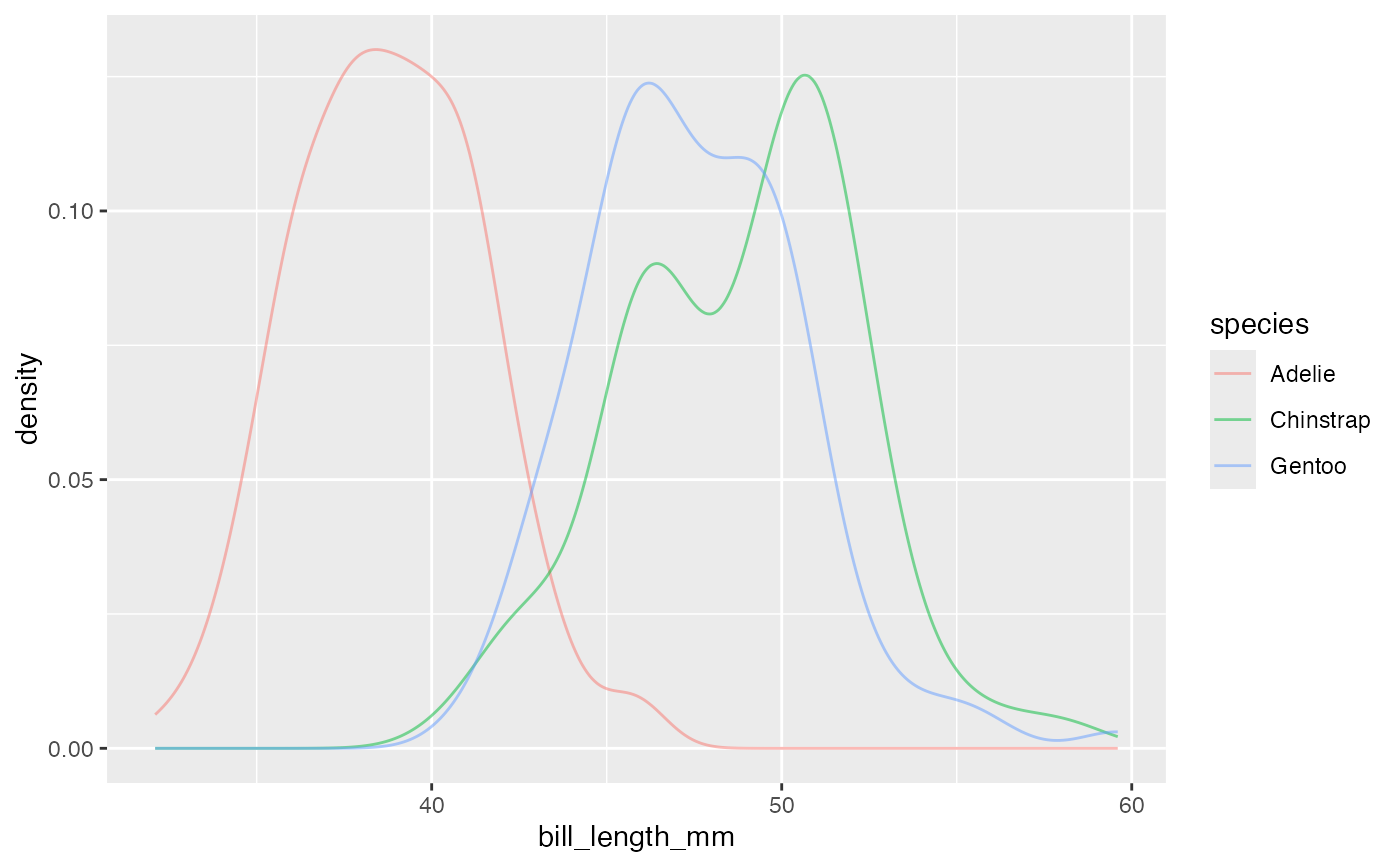 # horizontal orientation
penguins |> gf_dens(bill_length_mm ~ ., color = ~species)
#> Warning: Removed 2 rows containing non-finite outside the scale range
#> (`stat_density()`).
# horizontal orientation
penguins |> gf_dens(bill_length_mm ~ ., color = ~species)
#> Warning: Removed 2 rows containing non-finite outside the scale range
#> (`stat_density()`).
